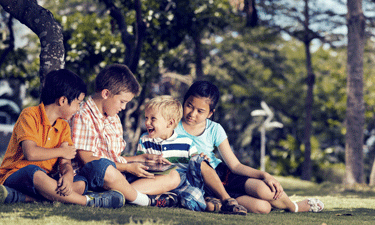 Children are heard laughing, yelling and jumping around as they hunt for macro-invertebrates in the river. Occasionally, a high-pitched shriek is heard as a child leans over a net that another has drawn from the water. They are so absorbed in the activity that they do not even notice the rain falling down. Notebook and pen in hand, I stand shivering and squint through foggy glasses at the children in the river. They are captivated by their activity in the river; nature seems to completely engross their every move.
Children are heard laughing, yelling and jumping around as they hunt for macro-invertebrates in the river. Occasionally, a high-pitched shriek is heard as a child leans over a net that another has drawn from the water. They are so absorbed in the activity that they do not even notice the rain falling down. Notebook and pen in hand, I stand shivering and squint through foggy glasses at the children in the river. They are captivated by their activity in the river; nature seems to completely engross their every move.
Later that afternoon the children sit huddled on benches, and only a few focus their attention on the two adults up front. The adults are explaining the afternoon’s activity to the group but many of the children are lost in their own thoughts. One adult holds up an iPad for all to see and in an instant the children’s attention is focused. They sit up straighter, a few can be heard gasping in excitement, and one girl raises are her hand eagerly. Previously bored and unengaged, they are now captivated and intrigued. I sit on a bench in the back, hands numb from the cold as I jot down notes, fascinated by the children’s reaction to the device.
A group of four students stand around a white bucket as one girl designates herself the leader and orders others. An adult comes by and offers the group an iPad to record their data. The girl tells the adult that her group is not ready for the iPad yet and quickly explains that they have not finished their assignment and turns her back. The other members in the group look hungrily at the iPad but continue their tasks as the adult walks away. As an observer, I am enthralled by one girl’s determination to complete the assignment one step at a time. Sometime later the adult returns to once again offer the group the iPad. The girl refuses, giving the same explanation as before. This routine is completed one more time before the adult gives up on the girl and passes the iPad to a different group member. The young boy quickly snatches the device from the adult and all of the group members crowd around the device in interest. Another boy notices a crayfish attempting to make a dash for freedom. With much laughing and screaming, the group members return to their assigned tasks and the iPad is left alone on the bench.
As a graduate student, I thought it would be interesting to understand the role of digital technologies in outdoor environmental education programs. In the beginning, it was challenging telling others about my graduate research. I would usually stumble through an explanation, never knowing if the individual listening would be accepting of my research or strongly against it. When I first started my research, the field of environmental education was split between two philosophies. One was vehemently against digital technologies, claiming the integration would negatively affect the positive and beneficial influence of nature. The other, a drastically different philosophy, believed that the integration of digital technologies is an appropriate way to present information to youth through more readily connected means.
It has been interesting, during the past year and half, to see firsthand how the field has changed. Before, when told about my research, many people would express their opinions negatively, finding no importance to my study. Now, people are only slightly wary, expressing interest and curiosity instead. Many have come to the conclusion that there is a time and place for these digital technologies. We cannot fight them, so instead we should embrace the educational potential and develop a method of integration that does not detract from the natural experience.
Nelson Mandela once said, “Education is the most powerful weapon which you can use to change the world.” As environmental educators, we aim to increase environmental literacy in those we educate and to instill a fierce love for nature that will encourage our children to choose to protect nature for their children and their children’s children. If fully educating our children means accepting possibilities for teaching that are not as conventional, but present the information through a means that better connect with our children, shouldn’t we at least give it a shot?
Joy Kacoroski is a graduate student at the University of Wisconsin Stevens Point where she is working toward a Master of Science in Natural Resources with an emphasis in Environmental Education and Interpretation.

